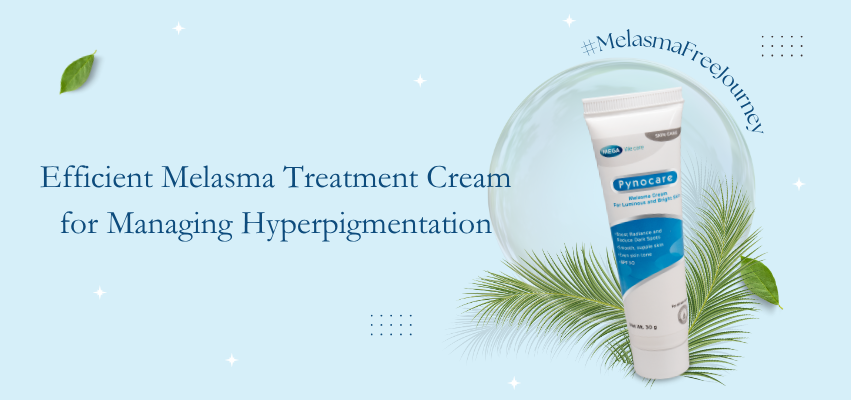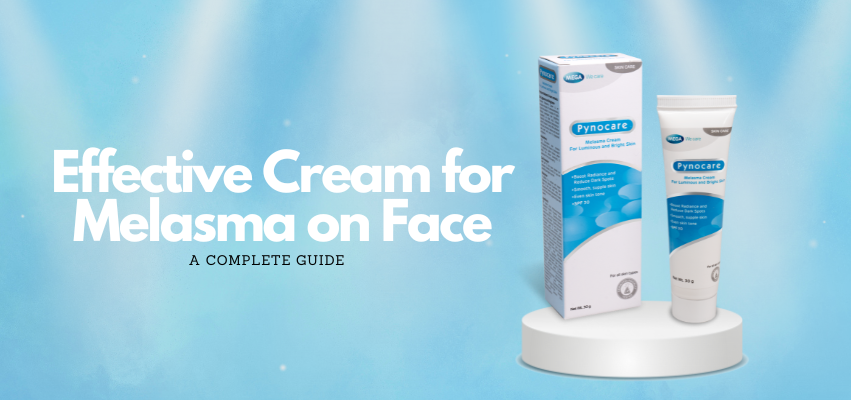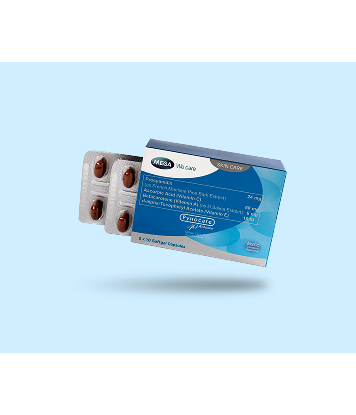Melasma is more common than people thought – especially in the Philippines where we tend to have darker skin tones and higher sun exposure throughout the year. This condition, characterized by stubborn discolored patches, can affect anyone but is more prevalent in women. This prompts many to ask, how does melasma go away? How do they develop in the first place? What lifestyle changes can we make? Can we take medications or oral supplements for it? Let’s answer all those burning questions below.
How Does Melasma Develop?
To understand melasma, imagine your skin as a canvas. The color of this canvas is determined by cells called melanocytes, which produce a pigment called melanin. Melanin gives your skin its color and protects it from the harmful effects of ultraviolet (UV) rays.
In melasma, melanocytes become overactive and produce too much melanin in certain areas of the skin. This overproduction results in dark patches. The exact cause of this overactivity isn’t fully understood, but several factors can trigger it:
- Sun Exposure
Ultraviolet (UV) Radiation: The sun’s UV rays are a major trigger for melasma. UV radiation stimulates melanocytes. When these cells are over-activated, they produce excess melanin, leading to the dark patches characteristic of melasma.
Visible Light and Infrared Radiation: Recent studies have shown that visible light and infrared radiation can also exacerbate melasma. These types of light penetrate deeper into the skin, causing more extensive damage and hyperpigmentation.
- Hormonal Changes
Pregnancy: Often referred to as the “mask of pregnancy” or chloasma, melasma is common during pregnancy due to elevated levels of estrogen and progesterone. These hormones can stimulate melanocytes, leading to increased melanin production.
Oral Contraceptives and Hormone Replacement Therapy: Women taking birth control pills or undergoing hormone replacement therapy are at a higher risk of developing melasma. The hormones in these medications can trigger melanocyte activity.
Thyroid Dysfunction: Some studies suggest a link between thyroid disorders and melasma, although the exact mechanism is not well understood.
- Genetics
Family History: If melasma runs in your family, you are more likely to develop the condition. Genetic predisposition plays a significant role, although the exact genes involved are still being studied.
- Skin Care Products
Cosmetics and Skin Care: Certain products can irritate the skin and trigger melasma. Ingredients like fragrances and some preservatives can cause inflammation, leading to hyperpigmentation.
Risk Factors for Melasma
While the exact causes of melasma are complex, several risk factors can increase the likelihood of developing the condition:
- Gender
Women: Approximately 90% of melasma cases occur in women. This is largely due to hormonal influences, such as pregnancy and the use of oral contraceptives.
- Skin Type
Darker Skin Tones: Individuals with Fitzpatrick skin types III to V (which includes many Filipinos) are more prone to melasma. These skin types have more active melanocytes, making them more susceptible to hyperpigmentation.
- Age
Adults: Melasma is most commonly seen in adults between the ages of 20 and 40. It rarely affects children or older adults.
- Ethnicity
Asian, Hispanic, African, and Middle Eastern Descent: People from these ethnic backgrounds are at a higher risk due to their naturally higher melanin levels and greater melanocyte activity.
- Geographic Location
Living in Sunny Climates: People living closer to the equator, where UV exposure is more intense, are at a higher risk. This includes many regions in Southeast Asia, such as the Philippines.
- Occupation
Outdoor Workers: Individuals who work outdoors and are frequently exposed to sunlight are more likely to develop melasma.
Prevalence in the Philippines
Melasma is particularly prevalent among Filipinos due to their darker skin tones and frequent sun exposure. According to a study published in the Journal of Clinical and Aesthetic Dermatology, melasma affects about 8.8% of women in Southeast Asia, which includes the Philippines. Another study in the Philippine Journal of Dermatology found that melasma is one of the most common dermatological conditions treated in dermatology clinics across the country. Given these statistics, it is no wonder that a lot of Filipinos are asking how does melasma go away. Let’s take a closer look in the next part of this article.
How Does Melasma Go Away?
There are several mechanisms on how to make melasma go away. Below are mechanisms that explain how melasma goes away.
- Inhibition of Tyrosinase: Many treatments for melasma aim to inhibit the activity of tyrosinase, thereby reducing melanin production. Reducing the enzyme’s activity decreases melanin synthesis, leading to the gradual fading of dark patches.
- Promotion of Skin Cell Turnover: By accelerating the shedding of the outermost layer of the skin, these agents help to remove melanin-laden keratinocytes more quickly. This process can gradually lighten hyperpigmented areas.
- Antioxidant Effects: By reducing oxidative stress, these antioxidants can help to stabilize melanocyte activity and reduce melanin synthesis.
- Anti-Inflammatory Effects: Inflammation can stimulate melanocytes and increase melanin production. Corticosteroids and other anti-inflammatory agents can help to reduce inflammation, thereby mitigating one of the triggers for melanin overproduction.
- Disruption of Melanin Transfer: Some treatments, like niacinamide, work by disrupting the transfer of melanin from melanocytes to keratinocytes. By preventing this transfer, these agents can reduce the visibility of dark patches.
How to Make Melasma Go Away
How does melasma go away? The answer is quite complicated. Treating melasma can also be challenging due to its multifactorial nature, but with the right approach it is not impossible. A combination of preventive measures, topical treatments, procedural interventions, and oral supplements can help manage and reduce its appearance. Below is a detailed overview of the available treatment options:
- Sun Protection
Sun protection is the cornerstone of how to make melasma go away. Consistent and effective sun protection can prevent the worsening of existing melasma and reduce the likelihood of developing new patches. Key strategies include:
- Broad-Spectrum Sunscreen: Use a sunscreen that protects against both UVA and UVB rays with an SPF of at least 30. Apply it generously and reapply every two hours, especially if you’re outdoors.
- Physical Barriers: Wear wide-brimmed hats, sunglasses, and protective clothing to shield your skin from direct sunlight.
- Avoid Peak Sun Hours: Try to stay indoors between 10 a.m. and 4 p.m., when the sun’s rays are the strongest.
- Topical Treatments
Topical treatments are often the first line of defense against melasma. These treatments focus on reducing melanin production and lightening the dark patches. Common topical agents include:
- Hydroquinone: A tyrosinase inhibitor often considered the gold standard for melasma treatment. Hydroquinone is available in various concentrations, typically 2% over-the-counter and up to 4% by prescription.
- Tretinoin: A derivative of vitamin A that promotes skin cell turnover and helps fade dark spots. It is often used in combination with other treatments like hydroquinone.
- Corticosteroids: These are sometimes added to hydroquinone and tretinoin to reduce inflammation and enhance the lightening effect. However, long-term use of corticosteroids can have side effects, so they should be used cautiously.
- Azelaic Acid: A naturally occurring acid that helps to reduce melanin production and has anti-inflammatory properties. It is a good alternative for those who cannot tolerate hydroquinone.
- Kojic Acid: Derived from fungi, kojic acid is another melanin-inhibiting agent. It is often found in skin-lightening creams and serums.
- Niacinamide: A form of vitamin B3 that reduces the transfer of melanin to skin cells, helping to lighten dark patches.
- Procedural Treatments
For more stubborn cases of melasma, dermatologists may recommend procedural treatments. These should be performed by trained professionals to minimize the risk of complications:
- Chemical Peels: Use acids to exfoliate the skin, promoting the removal of pigmented cells.
- Laser Therapy: Targets and breaks down melanin deposits in the skin.
- Microneedling: Creates micro-injuries that promote collagen production and skin renewal, helping to improve the appearance of melasma.
- Intense Pulsed Light (IPL): Uses broad-spectrum light to target pigmentation, helping to break down melanin.
- Oral Treatments
Oral supplements can be an adjunct to topical and procedural treatments. One promising option is Pynocare, which contains a blend of procyanidin, and vitamins A, C, and E. It is an over the counter medication for melasma available nationwide in all leading drugstores and online via trusted distributors.
- Procyanidin: A potent antioxidant found in grape seeds, apples, and other plants. It helps reduce melanin production and protects the skin from oxidative stress.
- Vitamins A, C, and E: These vitamins offer multiple benefits, including antioxidant protection, reduced inflammation, and enhanced skin healing. Vitamin C, in particular, is known for its skin-brightening properties.
A clinical study published in the Journal of Cosmetic Dermatology showed that participants taking Pynocare experienced significant improvement in melasma symptoms, with reduced pigmentation and enhanced skin appearance.
- Combination Therapy
Often, the best results are achieved through a combination of treatments. Dermatologists may recommend using topical treatments in conjunction with procedural interventions and oral supplements to address melasma from multiple angles.
Conclusion
Melasma is a complex and often persistent skin condition that can significantly impact one’s quality of life. Understanding the pathophysiology of melasma—how it develops and how it can be treated—provides a foundation for effective management.
Effective treatment strategies focus on multiple pathways: inhibiting melanin production, promoting skin cell turnover, reducing oxidative stress, and mitigating inflammation. Oral supplements like Pynocare, which contain procyanidin and vitamins A, C, and E, offer additional benefits by addressing melasma from within.
References
Philipp-Dormston W. G. (2024). Melasma: A Step-by-Step Approach Towards a Multimodal Combination Therapy. Clinical, cosmetic and investigational dermatology, 17, 1203–1216. https://doi.org/10.2147/CCID.S372456
Gener-Pangilinan, L. A., Handog, E. B., Gabriel, M., Carpio, B. D., Lavadia, M. M., & Loginus, W. (2019). Prevalence, epidemiology and clinical characteristics of melasma in Philippine dermatology patients: A multicenter, cross-sectional study. Journal of the Philippine Medical Association, 28(1), pp. 15-23.
Chaowattanapanit, S., Silpa-Archa, N., Kohli, I., Lim, H. W., & Hamzavi, I. (2017). Postinflammatory hyperpigmentation: A comprehensive overview. Journal of the American Academy of Dermatology, 77(4), 607–621. https://doi.org/10.1016/j.jaad.2017.01.036
Ogbechie-Godec, O. A., & Elbuluk, N. (2017). Melasma: an Up-to-Date Comprehensive Review. Dermatology and Therapy, 7(3), 305–318. https://doi.org/10.1007/s13555-017-0194-1
Handog, E. B., Datuin, M. S. L., & Singzon, I. A. (2015). An open‐label, single‐arm trial of the safety and efficacy of a novel preparation of glutathione as a skin‐lightening agent in Filipino women. International Journal of Dermatology, 55(2), 153–157. https://doi.org/10.1111/ijd.12999
PYNOCARE (Procyanidin + Ascorbic Acid + Betacarotene + d-Alpha-Tocopheryl Acetate)
The first and only oral medicine that is clinically proven to reduce Melasma or dark spots formation in just 8 weeks. Unlike creams, lotions and gels, it has MSCC or Melasma Skin Clear Complexion Complex formulation that deeply penetrates the inner layers of the skin to help normalize melanin levels, thus minimizing the appearance of dark spots in a short time.
Mega Lifesciences Limited Inc. or Mega We Care, is actively involved in helping millions of people have access to safe, effective, world class quality nutritional & herbal supplements, OTC and ethical products.
![]()





















No Comments on How Does Melasma Go Away?